外研版Unit3Language inuseModule 1Travel课件(44张 )
文档属性
| 名称 | 外研版Unit3Language inuseModule 1Travel课件(44张 ) | 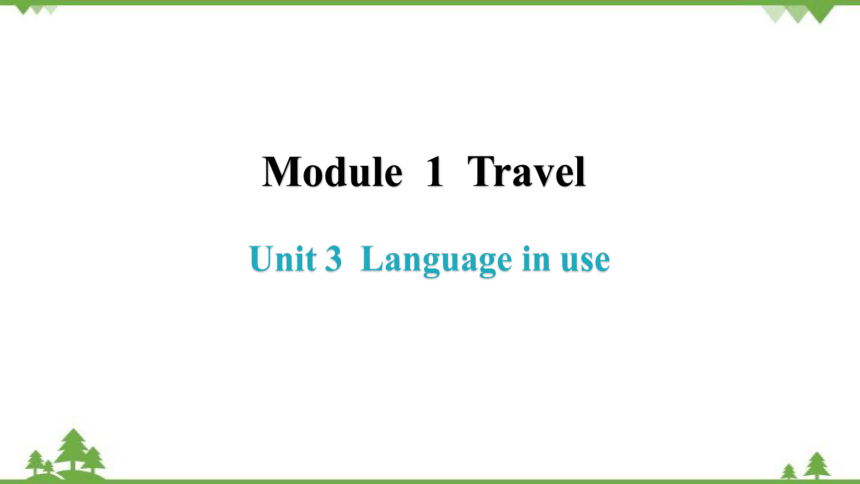 | |
| 格式 | pptx | ||
| 文件大小 | 267.5KB | ||
| 资源类型 | 教案 | ||
| 版本资源 | 外研版 | ||
| 科目 | 英语 | ||
| 更新时间 | 2022-06-16 21:08:28 | ||
图片预览

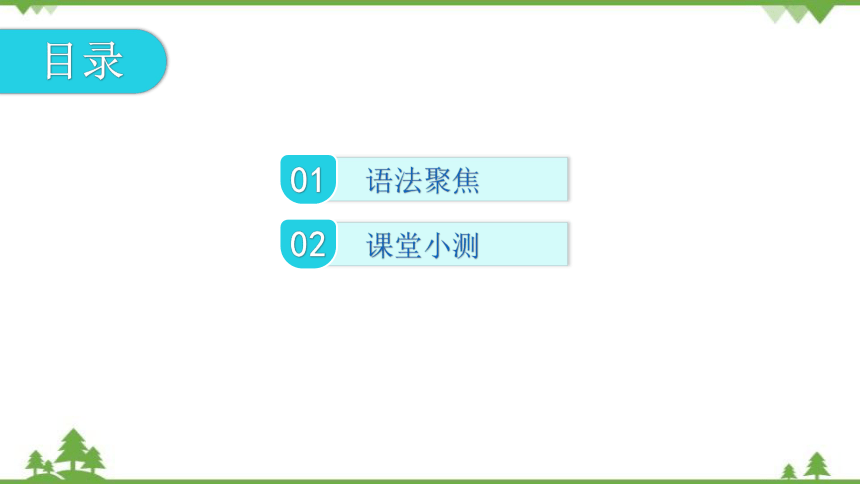
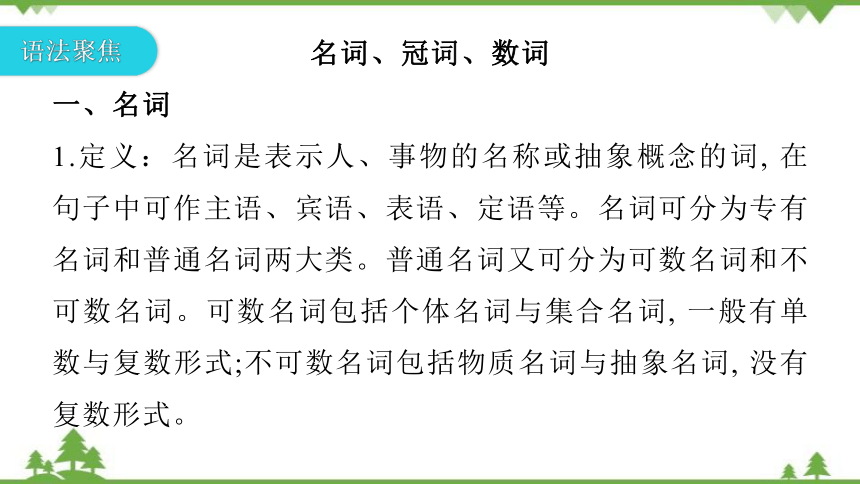

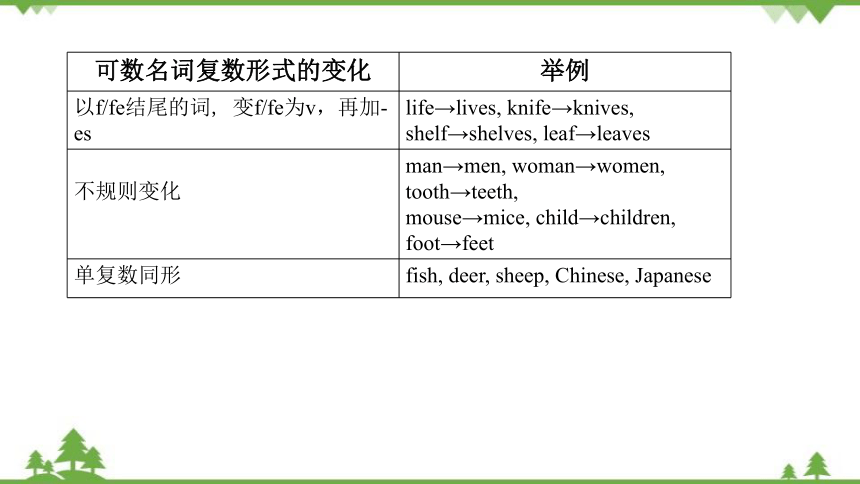
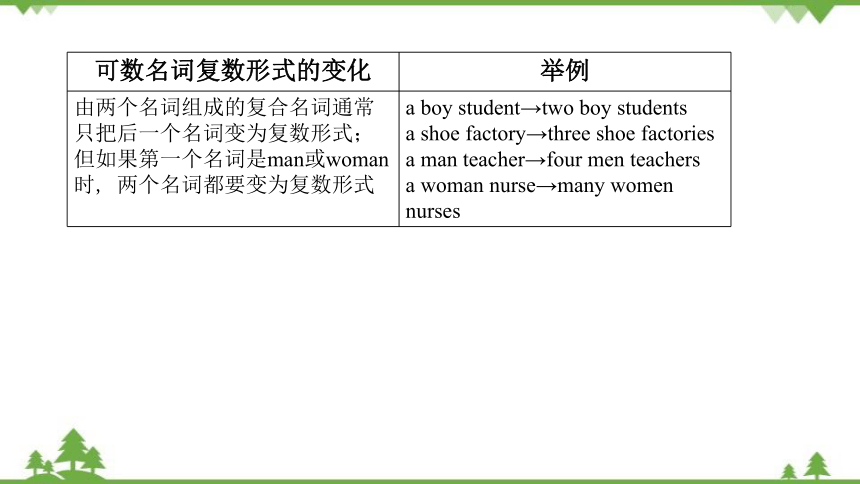
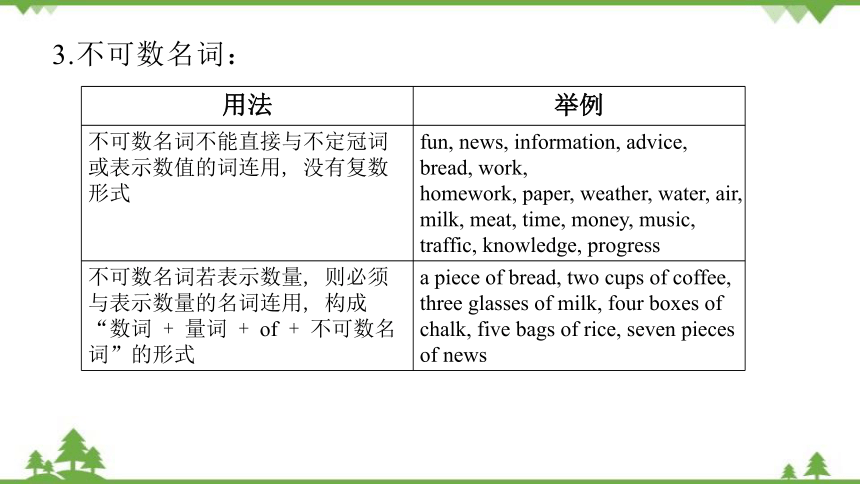
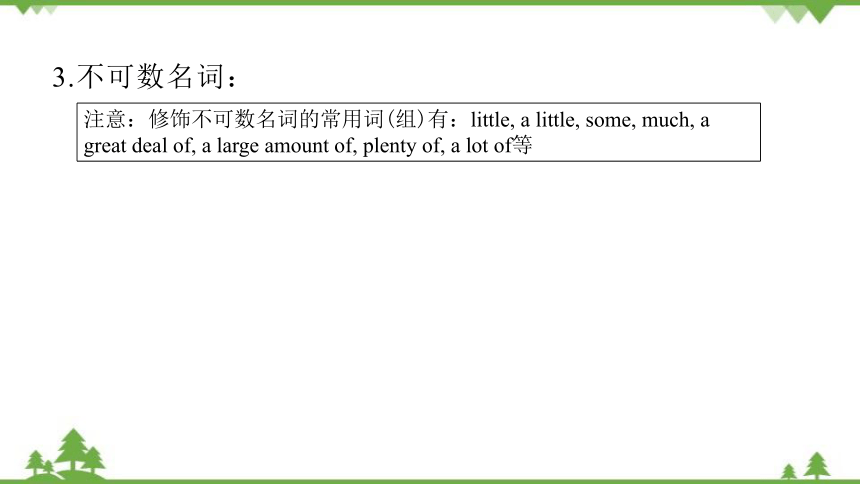
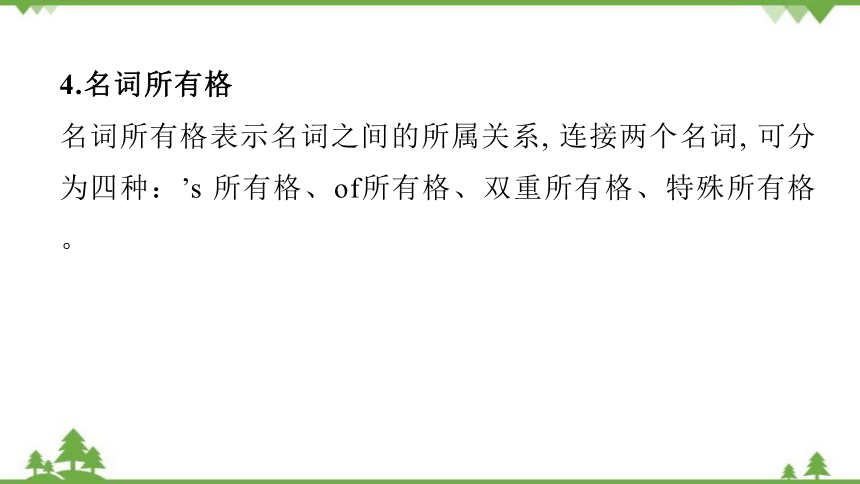
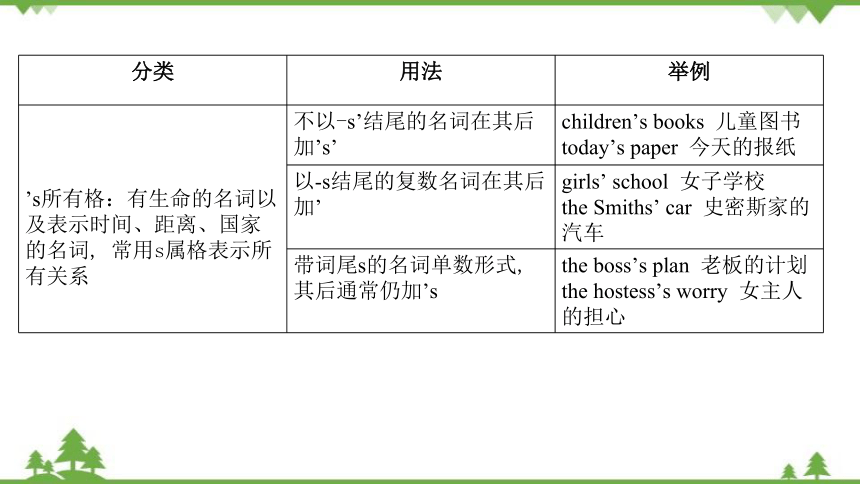
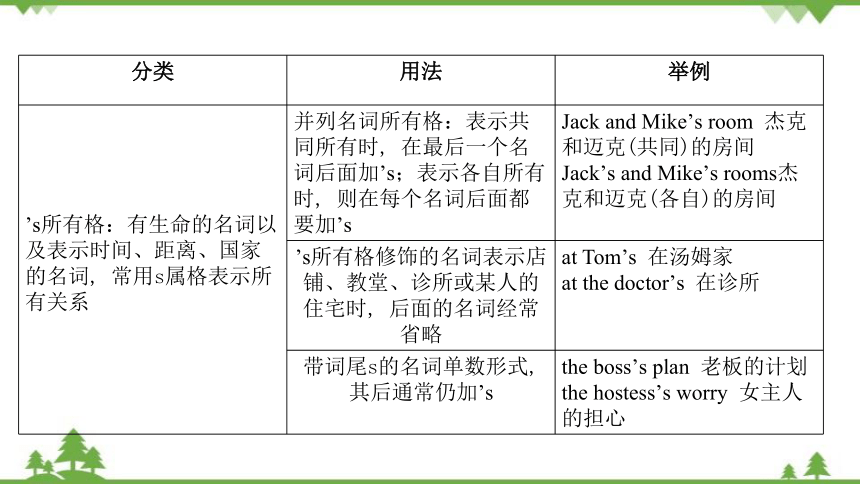
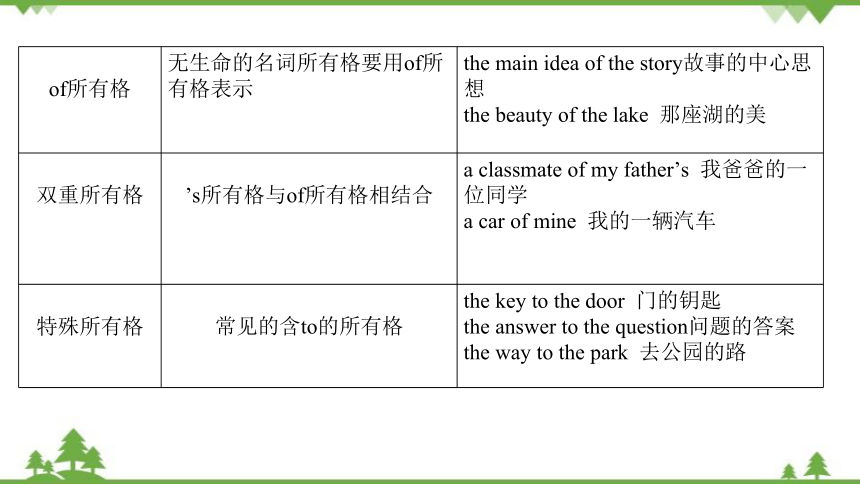
文档简介
(共44张PPT)
Unit 3 Language in use
Module 1 Travel
目录
语法聚焦
01
课堂小测
02
语法聚焦
名词、冠词、数词
一、名词
1.定义:名词是表示人、事物的名称或抽象概念的词, 在句子中可作主语、宾语、表语、定语等。名词可分为专有名词和普通名词两大类。普通名词又可分为可数名词和不可数名词。可数名词包括个体名词与集合名词, 一般有单数与复数形式;不可数名词包括物质名词与抽象名词, 没有复数形式。
2. 可数名词:
可数名词复数形式的变化 举例
一般直接在词尾加-s boy→boys, student→students, book→books
以s, x, ch, sh结尾的名词, 在词尾加-es bus→buses, box→boxes, watch→watches, wish→wishes
以o结尾的名词:有生命的(动植物)加-es没生命的加-s hero→heroes, tomato→tomatoes, potato→potatoes, photo→photos, piano→pianos, radio→radios,
kilo→kilos, zoo→zoos
以“辅音字母+y”结尾的词, 变y为i, 再加es family→families, baby→babies, party→parties
可数名词复数形式的变化 举例
以f/fe结尾的词, 变f/fe为v,再加-es life→lives, knife→knives, shelf→shelves, leaf→leaves
不规则变化 man→men, woman→women, tooth→teeth,
mouse→mice, child→children, foot→feet
单复数同形 fish, deer, sheep, Chinese, Japanese
可数名词复数形式的变化 举例
由两个名词组成的复合名词通常只把后一个名词变为复数形式;但如果第一个名词是man或woman时, 两个名词都要变为复数形式 a boy student→two boy students
a shoe factory→three shoe factories
a man teacher→four men teachers
a woman nurse→many women nurses
3.不可数名词:
用法 举例
不可数名词不能直接与不定冠词或表示数值的词连用, 没有复数形式 fun, news, information, advice, bread, work,
homework, paper, weather, water, air, milk, meat, time, money, music, traffic, knowledge, progress
不可数名词若表示数量, 则必须与表示数量的名词连用, 构成“数词 + 量词 + of + 不可数名词”的形式 a piece of bread, two cups of coffee, three glasses of milk, four boxes of chalk, five bags of rice, seven pieces of news
3.不可数名词:
注意:修饰不可数名词的常用词(组)有:little, a little, some, much, a great deal of, a large amount of, plenty of, a lot of等
4.名词所有格
名词所有格表示名词之间的所属关系, 连接两个名词, 可分为四种:’s 所有格、of所有格、双重所有格、特殊所有格。
分类 用法 举例
’s所有格:有生命的名词以及表示时间、距离、国家的名词, 常用s属格表示所有关系 不以-s’结尾的名词在其后加’s’ children’s books 儿童图书today’s paper 今天的报纸
以-s结尾的复数名词在其后加’ girls’ school 女子学校
the Smiths’ car 史密斯家的汽车
带词尾s的名词单数形式, 其后通常仍加’s the boss’s plan 老板的计划
the hostess’s worry 女主人的担心
分类 用法 举例
’s所有格:有生命的名词以及表示时间、距离、国家的名词, 常用s属格表示所有关系 并列名词所有格:表示共同所有时, 在最后一个名词后面加’s;表示各自所有时, 则在每个名词后面都要加’s Jack and Mike’s room 杰克和迈克(共同)的房间
Jack’s and Mike’s rooms杰克和迈克(各自)的房间
’s所有格修饰的名词表示店铺、教堂、诊所或某人的住宅时, 后面的名词经常省略 at Tom’s 在汤姆家
at the doctor’s 在诊所
带词尾s的名词单数形式, 其后通常仍加’s the boss’s plan 老板的计划
the hostess’s worry 女主人的担心
of所有格 无生命的名词所有格要用of所有格表示 the main idea of the story故事的中心思想
the beauty of the lake 那座湖的美
双重所有格 ’s所有格与of所有格相结合 a classmate of my father’s 我爸爸的一位同学
a car of mine 我的一辆汽车
特殊所有格 常见的含to的所有格 the key to the door 门的钥匙
the answer to the question问题的答案
the way to the park 去公园的路
二、冠词
1.定义:冠词作为一种虚词, 在英语中只能和名词一起使用。英语中的冠词分为不定冠词、定冠词以及零冠词。本模块主要讲解不定冠词、定冠词与零冠词的用法。不定冠词有a和an两种形式, 只能用在可数名词单数形式前, 其中a用在发音以辅音音素开头的单词前, an用在发音以元音音素开头的单词前。
二、冠词
定冠词只有the一种形式, 与指示代词this, that同源, 含有“这(那)个”的意思, 与名词连用, 表示某个或某些特定的人或事物。零冠词是指名词前面没有不定冠词(a, an)或定冠词(the), 也没有其他限定词的一种语言现象, 常用来表示名词的泛指或一般概念。零冠词也是冠词的一种, 一般表示为“/”, 而在文法中则根本不表示。
2.不定冠词、定冠词与零冠词的主要用法如下:
冠词 用法 举例
不定冠 词(a/an) (1)泛指某一类人或事物 (2)表示数量“一” (3)表示“某一个”, 不具体指明是何人何物 (4)表示“每一”, 相当于every, one (5)a + 序数词 + 名词:表示“又一;再一” (1)A plane is a machine that can fly.飞机是一种能飞的机器。
(2)There is an English book on the desk.桌子上有一本英语书。
(3)A man is waiting for you there.有一个人正在那儿等你。
(4)We study eight hours a day.我们每天学习八个小时。
(5)a third try 第三次尝试;
a second time 第二次
续表
冠词(the) (1)特指某(些)人或某(些)事物 (2)指谈话双方都知道的人或事物 (3)复述上文提过的人或事物 (4)世界上独一无二的事物前 (1)Pass me the apple, please.请递给我那个苹果。
(2)Where is the teacher 老师在哪儿?
(3)I have a nice wallet, but the wallet was stolen yesterday.我有一个不错的钱包, 但是昨天它被偷了。
(4)the sun, the earth, the moon 等
冠词(the) (5)方位名词、身体部位及表示时间的名词前 (6)在……世纪/年代前,在序数词、形容词最高级前 (7)和形容词连用表示“某一类人或事物”, 其后谓语动词用复数形式 (8)用于姓氏的复数形式前, 表示“某人一家”或这一姓氏的夫妇二人
(5)on the right, in the west of …, on the nose, in the morning
(6)in the 1990’s, the first child, the most interesting book
(7)The poor/rich/young/old are having lunch now.穷/富/年轻/老人们现在正在吃午饭。
(8)The Browns went to Beijing last Sunday.布朗夫妇上周日去了北京。
零冠词 (1)专有名词、物质名词、抽象名词、人名、地名等名词前 (2)名词前有this, my, whose, some, no, each, every等限制 (3)季节、月份、星期、节假日(中国传统节日除外)、一日三餐前 (4)学科、颜色、语言、球类、棋类名词前
(1)Peking University, air, love, Jack, China
(2)this tree, my book, some water
(3)spring, March, Sunday, National Day, lunch
(4)learn maths, in red, speak English, play football/chess
零冠词 (5)与by连用表示交通工具的名词前 (6)以and连接的两个并列的相对名词前 (7)表示泛指的名词复数形式前 (8)表示职位、头衔、身份等名词前
(5)by train, by air, by land
(6)husband and wife, knife and fork, day and
night
(7)Horses are useful animals.马是有用的动物。
(8)Professor Wang, Doctor
Thompson, President Lincoln
三、数词
1.定义:表示事物的数量或顺序的词叫作数词。数词分为两大类, 即基数词和序数词。基数词表示数目, 如:one, two, three …;序数词表示顺序, 如:first, second, third …, 序数词前一般要加the。英语中数词可以在句中充当句子成分, 如可作主语、定语、宾语、表语、同位语或状语等。
2.数词的构成
巧学妙记(基数词变序数词的口诀):
基变序, 有规律, 词尾加上th;
一二三, 特殊记, 词尾字母t, d, d;
八去t, 九去e, f来把ve替;
整十y要变ie, 后跟th莫忘记;
若是碰到几十几, 只变个位就可以。
3.数词的用法
(1)数词在句子中可以作主语、宾语、定语、表语、同位语和状语。如:
Two of them are workers from China. 他们之中有两名是来自中国的工人。(作主语)
I wanted three, but he gave me two. 我想要三个, 他却给了我两个。(作宾语)
There are twenty boy students in our class. 我们班有20个男生。(作定语)
I am eighteen. 我18岁。(作表语)
They two will go to the party with you. 他们两个将与你一起去参加那个聚会。(作同位语)
She always comes first. 她总是第一个到。(作状语)
(2)表示编号。如:
Room Five = the fifth room 五号房
Bus No.13 = the No.13 bus 13路公共汽车
Paragraph Two = the second paragraph 第二段
Page 10 = the tenth page 第10页
(3)表示年、世纪、年代。如:
(in)nineteen ninety-eight (在)1998年
(in)the 18th century (在)18世纪
(in)the 1920s/1920’s (在)20世纪20年代
in the forties 在40年代
The old man is now in his eighties. 这位老人现在已经80多岁了。
(4)表示分数、小数、百分数。如:
one second/a second/a half 二分之一 three fourths 四分之三
thirteen point five four 13.54 fifty-five percent 55%
(5)表示时间、距离。如:
ten minutes’ walk 十分钟的步行距离
an hour’s ride 一小时的骑程/车程
(6)构成名词性短语(基数词 + 连字符“-”+可数名词单数形式)作定语(注意:不能作表语)。如:
We’ll have a two-month holiday. 我们将有一个两个月的假期。
She is a five-year-old Chinese girl. 她是一个五岁的中国女孩。
课堂小测
一、根据句意及首字母提示,用单词的适当形式填空,每空一词
1. Show me your_________number and I’ll see whether we’re neighbours on board.
2. Who’s going to dance and sing during the school-__________ party this year
flight
leavers’
课堂小测
3. Take care and we’re all looking _______ to seeing you again.
4. Sit down and make yourself as __________ as you like.
5. It’s very______ of you to guide me through the jungle.
forward
nice
comfortable
二、找出下列句子的错误, 并在横线上进行更正
6. How many woman teachers are there in our grade
_________________________________________________
7. I’m hungry. Can you buy me two piece of breads
_________________________________________________
woman teachers改为women teachers
two piece of breads改为two pieces of bread
8. I came to this school two weeks ago so I’ve got a little friends here.
_________________________________________________
9. —Where’s Bob
—I think he’s in Tom’s and Mike’s room. _________________________________________________
a little friends改为few friends
Tom’s and Mike’s room改为Tom and Mike’s room
10. I can’t believe our maths teacher was born in 1960s. He looks so young!
_________________________________________________
in 1960s改为in 1960 / in the 1960s / 1960’s
三、单项填空(语法专练)
( )11. It took ______ people three months to build this great building.
A. two hundreds B. hundred of
C. hundreds of D. two hundred of
C
( )12. —Does your uncle go to work by______ car every day
—No, he sometimes takes______bus.
A. a; the B. the; a C. /; a D. a; /
( )13.Some small shops in Britain usually close for ______hour at______lunchtime.
A. an; the B. a; / C. a; the D. an; /
C
D
( )14. —Have you seen______ film Forrest Gump
—Yes. It’s one of ______ most amazing film.
A. a; the B. the; an C. a; an D. the; the
( )15.—You’ve dropped______ “f” in the word “giraffe”.
—Oh, ______letter “f” should be doubled.
A. a; a B. a; the C. an; the D. the; the
D
C
四、语法选择(核心素养:语言能力)
There are several ways you can find out about the countries and places you wish to visit. You can talk to friends who have travelled to the places, you can go and see a colour film about them, __16__ you can read a travel book. It seems that there are three kinds of travel books. The first are those that give a personal, subjective(主观的) idea of travels which their writer has got __17__.
These books can be useful __18__ the writers share their travelling experiences with others. The second kind are those books which give objective(客观的) __19__ of things to be done and seen. If a well?educated person has written such a book about the facts of a place, then it is more useful. The third kind are those books __20__ are called “a guide” to some place or other. If they are good, they will describe and explain the place in detail.
Like __21__ kind, they can be interesting and exciting, but their main purpose is to help the reader plan his travel __22__ the most practical way. __23__that the book does not describe everything as interesting, exciting or fantastic. You __24__ keep an open eyes on its date of publication(出版) because travel is very practical matter and many things change quickly in __25__ 21st century.
Finally, you should make sure that it’s easy to find the useful information for your travel.
( )16. A. or B. but
C. so D. then
( )17. A. he B. himself
C. his D. him
( )18. A. though B. before
C. if D. until
( )19. A. inform B. informing
C. information D. informations
( )20.A. who B. what
C. which D. when
A
B
C
C
C
( )21. A. the first B. first
C. one D. a first
( )22. A. by B. with
C. on D. in
( )23. A. Whenever B. Wherever
C. Whatever D. However
( )24. A. can also B. must also
C. also can D. also must
( )25. A. the B. a
C. / D. an
A
D
C
B
A
课后作业
Unit 3 Language in use
Module 1 Travel
目录
语法聚焦
01
课堂小测
02
语法聚焦
名词、冠词、数词
一、名词
1.定义:名词是表示人、事物的名称或抽象概念的词, 在句子中可作主语、宾语、表语、定语等。名词可分为专有名词和普通名词两大类。普通名词又可分为可数名词和不可数名词。可数名词包括个体名词与集合名词, 一般有单数与复数形式;不可数名词包括物质名词与抽象名词, 没有复数形式。
2. 可数名词:
可数名词复数形式的变化 举例
一般直接在词尾加-s boy→boys, student→students, book→books
以s, x, ch, sh结尾的名词, 在词尾加-es bus→buses, box→boxes, watch→watches, wish→wishes
以o结尾的名词:有生命的(动植物)加-es没生命的加-s hero→heroes, tomato→tomatoes, potato→potatoes, photo→photos, piano→pianos, radio→radios,
kilo→kilos, zoo→zoos
以“辅音字母+y”结尾的词, 变y为i, 再加es family→families, baby→babies, party→parties
可数名词复数形式的变化 举例
以f/fe结尾的词, 变f/fe为v,再加-es life→lives, knife→knives, shelf→shelves, leaf→leaves
不规则变化 man→men, woman→women, tooth→teeth,
mouse→mice, child→children, foot→feet
单复数同形 fish, deer, sheep, Chinese, Japanese
可数名词复数形式的变化 举例
由两个名词组成的复合名词通常只把后一个名词变为复数形式;但如果第一个名词是man或woman时, 两个名词都要变为复数形式 a boy student→two boy students
a shoe factory→three shoe factories
a man teacher→four men teachers
a woman nurse→many women nurses
3.不可数名词:
用法 举例
不可数名词不能直接与不定冠词或表示数值的词连用, 没有复数形式 fun, news, information, advice, bread, work,
homework, paper, weather, water, air, milk, meat, time, money, music, traffic, knowledge, progress
不可数名词若表示数量, 则必须与表示数量的名词连用, 构成“数词 + 量词 + of + 不可数名词”的形式 a piece of bread, two cups of coffee, three glasses of milk, four boxes of chalk, five bags of rice, seven pieces of news
3.不可数名词:
注意:修饰不可数名词的常用词(组)有:little, a little, some, much, a great deal of, a large amount of, plenty of, a lot of等
4.名词所有格
名词所有格表示名词之间的所属关系, 连接两个名词, 可分为四种:’s 所有格、of所有格、双重所有格、特殊所有格。
分类 用法 举例
’s所有格:有生命的名词以及表示时间、距离、国家的名词, 常用s属格表示所有关系 不以-s’结尾的名词在其后加’s’ children’s books 儿童图书today’s paper 今天的报纸
以-s结尾的复数名词在其后加’ girls’ school 女子学校
the Smiths’ car 史密斯家的汽车
带词尾s的名词单数形式, 其后通常仍加’s the boss’s plan 老板的计划
the hostess’s worry 女主人的担心
分类 用法 举例
’s所有格:有生命的名词以及表示时间、距离、国家的名词, 常用s属格表示所有关系 并列名词所有格:表示共同所有时, 在最后一个名词后面加’s;表示各自所有时, 则在每个名词后面都要加’s Jack and Mike’s room 杰克和迈克(共同)的房间
Jack’s and Mike’s rooms杰克和迈克(各自)的房间
’s所有格修饰的名词表示店铺、教堂、诊所或某人的住宅时, 后面的名词经常省略 at Tom’s 在汤姆家
at the doctor’s 在诊所
带词尾s的名词单数形式, 其后通常仍加’s the boss’s plan 老板的计划
the hostess’s worry 女主人的担心
of所有格 无生命的名词所有格要用of所有格表示 the main idea of the story故事的中心思想
the beauty of the lake 那座湖的美
双重所有格 ’s所有格与of所有格相结合 a classmate of my father’s 我爸爸的一位同学
a car of mine 我的一辆汽车
特殊所有格 常见的含to的所有格 the key to the door 门的钥匙
the answer to the question问题的答案
the way to the park 去公园的路
二、冠词
1.定义:冠词作为一种虚词, 在英语中只能和名词一起使用。英语中的冠词分为不定冠词、定冠词以及零冠词。本模块主要讲解不定冠词、定冠词与零冠词的用法。不定冠词有a和an两种形式, 只能用在可数名词单数形式前, 其中a用在发音以辅音音素开头的单词前, an用在发音以元音音素开头的单词前。
二、冠词
定冠词只有the一种形式, 与指示代词this, that同源, 含有“这(那)个”的意思, 与名词连用, 表示某个或某些特定的人或事物。零冠词是指名词前面没有不定冠词(a, an)或定冠词(the), 也没有其他限定词的一种语言现象, 常用来表示名词的泛指或一般概念。零冠词也是冠词的一种, 一般表示为“/”, 而在文法中则根本不表示。
2.不定冠词、定冠词与零冠词的主要用法如下:
冠词 用法 举例
不定冠 词(a/an) (1)泛指某一类人或事物 (2)表示数量“一” (3)表示“某一个”, 不具体指明是何人何物 (4)表示“每一”, 相当于every, one (5)a + 序数词 + 名词:表示“又一;再一” (1)A plane is a machine that can fly.飞机是一种能飞的机器。
(2)There is an English book on the desk.桌子上有一本英语书。
(3)A man is waiting for you there.有一个人正在那儿等你。
(4)We study eight hours a day.我们每天学习八个小时。
(5)a third try 第三次尝试;
a second time 第二次
续表
冠词(the) (1)特指某(些)人或某(些)事物 (2)指谈话双方都知道的人或事物 (3)复述上文提过的人或事物 (4)世界上独一无二的事物前 (1)Pass me the apple, please.请递给我那个苹果。
(2)Where is the teacher 老师在哪儿?
(3)I have a nice wallet, but the wallet was stolen yesterday.我有一个不错的钱包, 但是昨天它被偷了。
(4)the sun, the earth, the moon 等
冠词(the) (5)方位名词、身体部位及表示时间的名词前 (6)在……世纪/年代前,在序数词、形容词最高级前 (7)和形容词连用表示“某一类人或事物”, 其后谓语动词用复数形式 (8)用于姓氏的复数形式前, 表示“某人一家”或这一姓氏的夫妇二人
(5)on the right, in the west of …, on the nose, in the morning
(6)in the 1990’s, the first child, the most interesting book
(7)The poor/rich/young/old are having lunch now.穷/富/年轻/老人们现在正在吃午饭。
(8)The Browns went to Beijing last Sunday.布朗夫妇上周日去了北京。
零冠词 (1)专有名词、物质名词、抽象名词、人名、地名等名词前 (2)名词前有this, my, whose, some, no, each, every等限制 (3)季节、月份、星期、节假日(中国传统节日除外)、一日三餐前 (4)学科、颜色、语言、球类、棋类名词前
(1)Peking University, air, love, Jack, China
(2)this tree, my book, some water
(3)spring, March, Sunday, National Day, lunch
(4)learn maths, in red, speak English, play football/chess
零冠词 (5)与by连用表示交通工具的名词前 (6)以and连接的两个并列的相对名词前 (7)表示泛指的名词复数形式前 (8)表示职位、头衔、身份等名词前
(5)by train, by air, by land
(6)husband and wife, knife and fork, day and
night
(7)Horses are useful animals.马是有用的动物。
(8)Professor Wang, Doctor
Thompson, President Lincoln
三、数词
1.定义:表示事物的数量或顺序的词叫作数词。数词分为两大类, 即基数词和序数词。基数词表示数目, 如:one, two, three …;序数词表示顺序, 如:first, second, third …, 序数词前一般要加the。英语中数词可以在句中充当句子成分, 如可作主语、定语、宾语、表语、同位语或状语等。
2.数词的构成
巧学妙记(基数词变序数词的口诀):
基变序, 有规律, 词尾加上th;
一二三, 特殊记, 词尾字母t, d, d;
八去t, 九去e, f来把ve替;
整十y要变ie, 后跟th莫忘记;
若是碰到几十几, 只变个位就可以。
3.数词的用法
(1)数词在句子中可以作主语、宾语、定语、表语、同位语和状语。如:
Two of them are workers from China. 他们之中有两名是来自中国的工人。(作主语)
I wanted three, but he gave me two. 我想要三个, 他却给了我两个。(作宾语)
There are twenty boy students in our class. 我们班有20个男生。(作定语)
I am eighteen. 我18岁。(作表语)
They two will go to the party with you. 他们两个将与你一起去参加那个聚会。(作同位语)
She always comes first. 她总是第一个到。(作状语)
(2)表示编号。如:
Room Five = the fifth room 五号房
Bus No.13 = the No.13 bus 13路公共汽车
Paragraph Two = the second paragraph 第二段
Page 10 = the tenth page 第10页
(3)表示年、世纪、年代。如:
(in)nineteen ninety-eight (在)1998年
(in)the 18th century (在)18世纪
(in)the 1920s/1920’s (在)20世纪20年代
in the forties 在40年代
The old man is now in his eighties. 这位老人现在已经80多岁了。
(4)表示分数、小数、百分数。如:
one second/a second/a half 二分之一 three fourths 四分之三
thirteen point five four 13.54 fifty-five percent 55%
(5)表示时间、距离。如:
ten minutes’ walk 十分钟的步行距离
an hour’s ride 一小时的骑程/车程
(6)构成名词性短语(基数词 + 连字符“-”+可数名词单数形式)作定语(注意:不能作表语)。如:
We’ll have a two-month holiday. 我们将有一个两个月的假期。
She is a five-year-old Chinese girl. 她是一个五岁的中国女孩。
课堂小测
一、根据句意及首字母提示,用单词的适当形式填空,每空一词
1. Show me your_________number and I’ll see whether we’re neighbours on board.
2. Who’s going to dance and sing during the school-__________ party this year
flight
leavers’
课堂小测
3. Take care and we’re all looking _______ to seeing you again.
4. Sit down and make yourself as __________ as you like.
5. It’s very______ of you to guide me through the jungle.
forward
nice
comfortable
二、找出下列句子的错误, 并在横线上进行更正
6. How many woman teachers are there in our grade
_________________________________________________
7. I’m hungry. Can you buy me two piece of breads
_________________________________________________
woman teachers改为women teachers
two piece of breads改为two pieces of bread
8. I came to this school two weeks ago so I’ve got a little friends here.
_________________________________________________
9. —Where’s Bob
—I think he’s in Tom’s and Mike’s room. _________________________________________________
a little friends改为few friends
Tom’s and Mike’s room改为Tom and Mike’s room
10. I can’t believe our maths teacher was born in 1960s. He looks so young!
_________________________________________________
in 1960s改为in 1960 / in the 1960s / 1960’s
三、单项填空(语法专练)
( )11. It took ______ people three months to build this great building.
A. two hundreds B. hundred of
C. hundreds of D. two hundred of
C
( )12. —Does your uncle go to work by______ car every day
—No, he sometimes takes______bus.
A. a; the B. the; a C. /; a D. a; /
( )13.Some small shops in Britain usually close for ______hour at______lunchtime.
A. an; the B. a; / C. a; the D. an; /
C
D
( )14. —Have you seen______ film Forrest Gump
—Yes. It’s one of ______ most amazing film.
A. a; the B. the; an C. a; an D. the; the
( )15.—You’ve dropped______ “f” in the word “giraffe”.
—Oh, ______letter “f” should be doubled.
A. a; a B. a; the C. an; the D. the; the
D
C
四、语法选择(核心素养:语言能力)
There are several ways you can find out about the countries and places you wish to visit. You can talk to friends who have travelled to the places, you can go and see a colour film about them, __16__ you can read a travel book. It seems that there are three kinds of travel books. The first are those that give a personal, subjective(主观的) idea of travels which their writer has got __17__.
These books can be useful __18__ the writers share their travelling experiences with others. The second kind are those books which give objective(客观的) __19__ of things to be done and seen. If a well?educated person has written such a book about the facts of a place, then it is more useful. The third kind are those books __20__ are called “a guide” to some place or other. If they are good, they will describe and explain the place in detail.
Like __21__ kind, they can be interesting and exciting, but their main purpose is to help the reader plan his travel __22__ the most practical way. __23__that the book does not describe everything as interesting, exciting or fantastic. You __24__ keep an open eyes on its date of publication(出版) because travel is very practical matter and many things change quickly in __25__ 21st century.
Finally, you should make sure that it’s easy to find the useful information for your travel.
( )16. A. or B. but
C. so D. then
( )17. A. he B. himself
C. his D. him
( )18. A. though B. before
C. if D. until
( )19. A. inform B. informing
C. information D. informations
( )20.A. who B. what
C. which D. when
A
B
C
C
C
( )21. A. the first B. first
C. one D. a first
( )22. A. by B. with
C. on D. in
( )23. A. Whenever B. Wherever
C. Whatever D. However
( )24. A. can also B. must also
C. also can D. also must
( )25. A. the B. a
C. / D. an
A
D
C
B
A
课后作业
同课章节目录
- Module 1 Travel
- Unit 1 We toured the city by bus and by taxi
- Unit 2 It's a long story.
- Unit 3 Language in use
- Module 2 Education
- Unit 1 They don't sit in rows.
- Unit 2 What do I like best about school?
- Unit 3 Language in use
- Module 3 Life now and then
- Unit 1 They sometimes work harder.
- Unit 2 I think life is better today.
- Unit 3 Language in use.
- Module 4 Rules and suggestions
- Unit 1 You must be careful of falling stones.
- Unit 2 we must keep the camp clean.
- Unit 3 Language in use.
- Revison A
- Module 5 Look after yourself
- Unit 1 We'd better get you to hospital.
- Unit 2 Get off the sofa!
- Unit 3 Language in use.
- Module 6 Eating togethe
- Unit 1 When is the school-leavers' party?
- Unit 2 Knives and forks are used for most Western
- Unit 3 Language in use
- Module 7 English for you and me
- Unit 1 Have you ever been to an English corner?
- Unit 2 We all own English.
- Unit 3 Language in use
- Module 8 My future life
- Unit 1 Here's to our friendship and the future
- Unit 2 I know that you will be better at maths.
- Unit 3 Language in use
- Revison B
